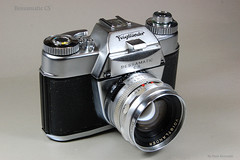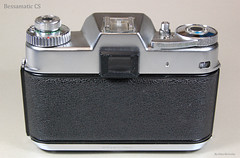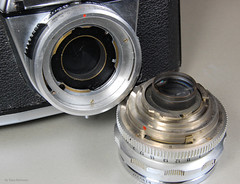Difference between revisions of "Bessamatic"
Hanskerensky (talk | contribs) (→Links: Weeded out links to Sylvain Halgand's website. Way too much !) |
m (→Bessamatic lenses) |
||
| (11 intermediate revisions by 6 users not shown) | |||
| Line 10: | Line 10: | ||
The '''Bessamatic''' was launched by [[Voigtländer]] in 1959, a few years after the 1953 [[Contaflex (SLR)|Contaflex]] and the 1957 [[Retina Reflex]], all from Germany. This is by far the biggest and heaviest of these three leaf-shuttered [[SLR]] cameras, at more than 2 lbs. or 0.935kg. The late arrival at the market has helped Voigtländer improve the ergonomic design taking advantage of previous designs. Nevertheless, it has all the shortcomings found on these cameras, the finder blackout after exposure and the limited range of interchangeable lenses. | The '''Bessamatic''' was launched by [[Voigtländer]] in 1959, a few years after the 1953 [[Contaflex (SLR)|Contaflex]] and the 1957 [[Retina Reflex]], all from Germany. This is by far the biggest and heaviest of these three leaf-shuttered [[SLR]] cameras, at more than 2 lbs. or 0.935kg. The late arrival at the market has helped Voigtländer improve the ergonomic design taking advantage of previous designs. Nevertheless, it has all the shortcomings found on these cameras, the finder blackout after exposure and the limited range of interchangeable lenses. | ||
| − | The Bessamatic is easy to handle and the controls are sound and reliable. The shutter is the behind the lens SLR [[Synchro-Compur]], as found on its fellow competitors, with the [[EV]] cross-coupled shutter speed and aperture rings. The viewfinder is bright and the focusing screen has a split image rangefinder, probably the same as found in contemporary Contaflex cameras. The focusing ring is at the front of the lens. The selenium meter cell window is above the lens, in front of the finder prism where it out of the way for light-obstructing fingers. The light meter needle is visible to the right in the viewfinder, as is a follower pointer with a small circle at the tip. They are easily brought to coincide using the large aperture-control knob under the smaller rewind knob. | + | The Bessamatic is easy to handle and the controls are sound and reliable. The shutter is the behind the lens SLR [[Synchro-Compur]] and part of the [[DKL-mount]], as found on its fellow competitors, with the [[EV]] cross-coupled shutter speed and aperture rings. The viewfinder is bright and the focusing screen has a split image rangefinder, probably the same as found in contemporary Contaflex cameras. The focusing ring is at the front of the lens. The selenium meter cell window is above the lens, in front of the finder prism where it out of the way for light-obstructing fingers. The light meter needle is visible to the right in the viewfinder, as is a follower pointer with a small circle at the tip. They are easily brought to coincide using the large aperture-control knob under the smaller rewind knob. |
The camera has a sturdy wind-on lever at the right-hand side with a flimsy film reminder in the hub. Next to it is the shutter release and the rewind release lever. At the left-hand side is the rewind knob at top of the large aperture knob. A small lever on the left-hand side of the shutter housing have settings for [[flash sync#X_Sync|M and X]] flash synchronisation, as well as [[self-timer|V]] for self-timer, shifted when a small button is depressed on the opposite side of the shutter housing. | The camera has a sturdy wind-on lever at the right-hand side with a flimsy film reminder in the hub. Next to it is the shutter release and the rewind release lever. At the left-hand side is the rewind knob at top of the large aperture knob. A small lever on the left-hand side of the shutter housing have settings for [[flash sync#X_Sync|M and X]] flash synchronisation, as well as [[self-timer|V]] for self-timer, shifted when a small button is depressed on the opposite side of the shutter housing. | ||
| Line 16: | Line 16: | ||
The camera back is opened by pushing two small latch buttons against each other using two fingers. The rewind knob is fully extended to load the film cassette. The only quite unusually odd thing about this camera is the frame counter, not the readout itself situated quite conveniently at the back, - below the wind-on lever, but the way in which it is reset. To set it, the film advance sprocket drum, next to the take-up spool, must be turned, using the thumb at the ridged middle part until reaching the desired number. It is difficult, time consuming and not very practical. Otherwise, the interior is beautifully finished and the film easily loaded. | The camera back is opened by pushing two small latch buttons against each other using two fingers. The rewind knob is fully extended to load the film cassette. The only quite unusually odd thing about this camera is the frame counter, not the readout itself situated quite conveniently at the back, - below the wind-on lever, but the way in which it is reset. To set it, the film advance sprocket drum, next to the take-up spool, must be turned, using the thumb at the ridged middle part until reaching the desired number. It is difficult, time consuming and not very practical. Otherwise, the interior is beautifully finished and the film easily loaded. | ||
| − | The lenses available for the Bessamatic is quite comprehensive, ranging from 35mm to 350mm and considered being of superior quality, but rather expensive second hand, since not easily found. The Bessamatic is often associated with the first 35mm zoom lens, the 36 to 82mm f/2.8 Zoomar made by the Zoomar Corporation of USA. | + | The lenses available for the Bessamatic is quite comprehensive, ranging from 35mm to 350mm and considered being of superior quality, but rather expensive second hand, since not easily found. The Bessamatic is often associated with the first 35mm [[Zoom lens | zoom lens,]] the 36 to 82mm f/2.8 Zoomar made by the Zoomar Corporation of USA. |
== Further Bessamatic models == | == Further Bessamatic models == | ||
| − | In 1962 an improved model, known as the '''Bessamatic deluxe''' was introduced, with all the settings on the lens visible in the viewfinder, externally recognisable by a small protrusion above the selenium meter cell at the front of the pentaprism. More importantly, though, is the addition of a small turning knob next to the wind lever enabling a much easier way to reset the frame counter. One might only wonder why not make it automatic. - The answer is that the counter is not set to zero, but to the number of frames on the film loaded. The 36-frame film is set at a diamond and the 20-frame film at a circle with a dot in the middle on the counter scale, and it counts down, but it does not lock the winding-on at zero. | + | In 1962 an improved model, known as the '''Bessamatic deluxe''' was introduced, with all the settings on the lens visible in the viewfinder, externally recognisable by a small protrusion above the selenium meter cell at the front of the pentaprism. |
| + | |||
| + | {{Flickr_image | ||
| + | |image_source= https://www.flickr.com/photos/148717487@N03/51575067925/in/pool-camerawiki/ | ||
| + | |image= https://live.staticflickr.com/65535/51575067925_6d8b37cf43.jpg | ||
| + | |image_align= center | ||
| + | |image_text= Bessamatic Deluxe viewfinder with speed and aperture visible on top and floating lightmeter needle | ||
| + | |image_by= Wagner Lungov | ||
| + | |image_rights= non-commercial | ||
| + | }} | ||
| + | More importantly, though, is the addition of a small turning knob next to the wind lever enabling a much easier way to reset the frame counter. One might only wonder why not make it automatic. - The answer is that the counter is not set to zero, but to the number of frames on the film loaded. The 36-frame film is set at a diamond and the 20-frame film at a circle with a dot in the middle on the counter scale, and it counts down, but it does not lock the winding-on at zero. | ||
{| class="plainlinks" align="center" style="text-align: center;" | {| class="plainlinks" align="center" style="text-align: center;" | ||
| Line 27: | Line 37: | ||
|} | |} | ||
| − | In 1964, a meter-less '''Bessamatic m''' was introduced, and finally the '''Bessamatic CS''' was produced from 1967 to 1969 with a TTL CdS meter. It is an improved Bessamatic Deluxe with the battery compartment | + | In 1964, a meter-less '''Bessamatic m''' was introduced, and finally the '''Bessamatic CS''' was produced from 1967 to 1969 with a TTL CdS meter. It is an improved Bessamatic Deluxe with the battery compartment behind a door at the front of the finder prism (occupying the space of the selenium photocell in other models) and an added accessory shoe at the top. The frame counter in the CS model counts upwards - that is, it counts the number of frames taken, not remaining - and is reset on opening the film door. |
{|class=floatleft | {|class=floatleft | ||
| Line 61: | Line 71: | ||
== Bessamatic lenses == | == Bessamatic lenses == | ||
| + | {| class="wikitable floatright" | ||
| + | | | ||
{{Flickr_image | {{Flickr_image | ||
|image_source= http://www.flickr.com/photos/ricksoloway/2810210248/in/pool-camerawiki | |image_source= http://www.flickr.com/photos/ricksoloway/2810210248/in/pool-camerawiki | ||
| − | |image= http://farm4.static.flickr.com/3202/ | + | |image= http://farm4.static.flickr.com/3202/2438753583_0ff48309e4_n.jpg |
|image_align= right | |image_align= right | ||
|image_text= Pre-1962 [[selenium meter]] Bessamatic | |image_text= Pre-1962 [[selenium meter]] Bessamatic | ||
| Line 69: | Line 81: | ||
|image_rights= with permission | |image_rights= with permission | ||
}} | }} | ||
| − | The range of Bessamatic lenses was as follows: | + | | |
| + | {{Flickr_image | ||
| + | |image_source= https://www.flickr.com/photos/90900361@N08/51385761193/in/pool-camerawiki | ||
| + | |image= https://live.staticflickr.com/65535/51385761193_8b3ffe1c7a_n.jpg | ||
| + | |image_align= right | ||
| + | |image_text= Bessamatic with 50mm f2.8 Color Skopar-X | ||
| + | |image_by= Geoff Harrisson | ||
| + | |image_rights= wp | ||
| + | }} | ||
| + | |- | ||
| + | | | ||
| + | {{Flickr_image | ||
| + | |image_source=https://www.flickr.com/photos/hsandler/51913024944/in/pool-camerawiki/ | ||
| + | |image=https://live.staticflickr.com/65535/51913024944_9e7e74da96_n.jpg | ||
| + | |image_align= center | ||
| + | |image_text= Voigtlander Bessamatic Deluxe <br> Skoparex 35mm f2.4 <br> Color-Skopar X 50mm f2.8<br>Dynarex 100mm f4.8 | ||
| + | |image_by= Howard Sandler | ||
| + | |image_rights= wp | ||
| + | }} | ||
| + | |} | ||
| + | |||
| + | The range of [[DKL-mount]] Bessamatic lenses was as follows: | ||
* 35mm f3.4 Skoparex | * 35mm f3.4 Skoparex | ||
* 40mm f2.0 Skopagon | * 40mm f2.0 Skopagon | ||
| Line 81: | Line 114: | ||
*350mm f5.6 Super Dynarex | *350mm f5.6 Super Dynarex | ||
*36–82mm f2.8 Zoomar | *36–82mm f2.8 Zoomar | ||
| + | |||
| + | |||
| + | {{br}} | ||
== Links == | == Links == | ||
| Line 86: | Line 122: | ||
* [http://www.photoethnography.com/ClassicCameras/index-frameset.html?VoigtlanderBessamatic.html~mainFrame Bessamatic on Photoethnography] by Karen Nakamura | * [http://www.photoethnography.com/ClassicCameras/index-frameset.html?VoigtlanderBessamatic.html~mainFrame Bessamatic on Photoethnography] by Karen Nakamura | ||
* [http://rick_oleson.tripod.com/index-150.html Use Retina Reflex Lenses on your Voigtlander Bessamatic (and vice versa)] | * [http://rick_oleson.tripod.com/index-150.html Use Retina Reflex Lenses on your Voigtlander Bessamatic (and vice versa)] | ||
| + | * [https://apenasimagens.com/en/voigtlander-bessamatic-zoomar-septon-super-dynarex-skopar-skoparex/ Bessamatic on apenasimagens.com] by Wagner Lungov | ||
| + | * [https://www.butkus.org/chinon/voigtlander_pdf/voigtlander_bessamatic/voigtlander_bessamatic.htm Voigtlander Bessamatic PDF manual (English & Italian] at [https://www.butkus.org/chinon/index.html Butkus' OrphanCameras.com] | ||
In French: | In French: | ||
* [http://www.collection-appareils.fr/x/html/page_standard.php?id_appareil=853 Bessamatic] at [http://www.collection-appareils.fr www.collection-appareils.fr] by Sylvain Halgand | * [http://www.collection-appareils.fr/x/html/page_standard.php?id_appareil=853 Bessamatic] at [http://www.collection-appareils.fr www.collection-appareils.fr] by Sylvain Halgand | ||
* [http://www.collection-appareils.fr/x/html/page_standard.php?id_appareil=11778 Bessamatic m] at [http://www.collection-appareils.fr www.collection-appareils.fr] by Sylvain Halgand | * [http://www.collection-appareils.fr/x/html/page_standard.php?id_appareil=11778 Bessamatic m] at [http://www.collection-appareils.fr www.collection-appareils.fr] by Sylvain Halgand | ||
| + | In German: | ||
| + | * [https://www.butkus.org/chinon/voigtlander_pdf/voigtlander_bessamatic/voigtlander_bessamatic.htm Voigtlander Bessamatic / Bessamatic CS PDF manual] at [https://www.butkus.org/chinon/index.htm Butkus' OrphanCameras.com] | ||
[[Category: German 35mm leaf shutter SLR]] | [[Category: German 35mm leaf shutter SLR]] | ||
[[Category: Voigtländer]] | [[Category: Voigtländer]] | ||
[[Category: B]] | [[Category: B]] | ||
Latest revision as of 18:58, 1 August 2022

|
| Bessamatic Deluxe with Zoomar 36-82mm f/2.8 image by Bryan Costin (Image rights) |
The Bessamatic was launched by Voigtländer in 1959, a few years after the 1953 Contaflex and the 1957 Retina Reflex, all from Germany. This is by far the biggest and heaviest of these three leaf-shuttered SLR cameras, at more than 2 lbs. or 0.935kg. The late arrival at the market has helped Voigtländer improve the ergonomic design taking advantage of previous designs. Nevertheless, it has all the shortcomings found on these cameras, the finder blackout after exposure and the limited range of interchangeable lenses.
The Bessamatic is easy to handle and the controls are sound and reliable. The shutter is the behind the lens SLR Synchro-Compur and part of the DKL-mount, as found on its fellow competitors, with the EV cross-coupled shutter speed and aperture rings. The viewfinder is bright and the focusing screen has a split image rangefinder, probably the same as found in contemporary Contaflex cameras. The focusing ring is at the front of the lens. The selenium meter cell window is above the lens, in front of the finder prism where it out of the way for light-obstructing fingers. The light meter needle is visible to the right in the viewfinder, as is a follower pointer with a small circle at the tip. They are easily brought to coincide using the large aperture-control knob under the smaller rewind knob.
The camera has a sturdy wind-on lever at the right-hand side with a flimsy film reminder in the hub. Next to it is the shutter release and the rewind release lever. At the left-hand side is the rewind knob at top of the large aperture knob. A small lever on the left-hand side of the shutter housing have settings for M and X flash synchronisation, as well as V for self-timer, shifted when a small button is depressed on the opposite side of the shutter housing.
The camera back is opened by pushing two small latch buttons against each other using two fingers. The rewind knob is fully extended to load the film cassette. The only quite unusually odd thing about this camera is the frame counter, not the readout itself situated quite conveniently at the back, - below the wind-on lever, but the way in which it is reset. To set it, the film advance sprocket drum, next to the take-up spool, must be turned, using the thumb at the ridged middle part until reaching the desired number. It is difficult, time consuming and not very practical. Otherwise, the interior is beautifully finished and the film easily loaded.
The lenses available for the Bessamatic is quite comprehensive, ranging from 35mm to 350mm and considered being of superior quality, but rather expensive second hand, since not easily found. The Bessamatic is often associated with the first 35mm zoom lens, the 36 to 82mm f/2.8 Zoomar made by the Zoomar Corporation of USA.
Further Bessamatic models
In 1962 an improved model, known as the Bessamatic deluxe was introduced, with all the settings on the lens visible in the viewfinder, externally recognisable by a small protrusion above the selenium meter cell at the front of the pentaprism.
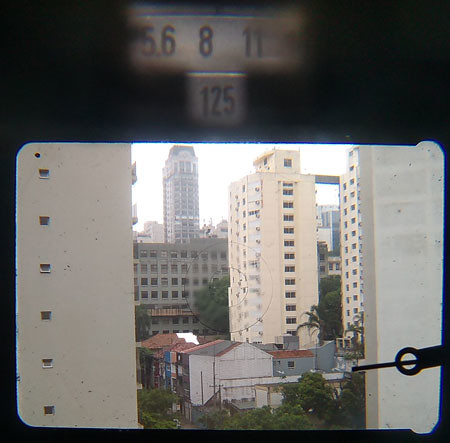
|
| Bessamatic Deluxe viewfinder with speed and aperture visible on top and floating lightmeter needle image by Wagner Lungov (Image rights) |
More importantly, though, is the addition of a small turning knob next to the wind lever enabling a much easier way to reset the frame counter. One might only wonder why not make it automatic. - The answer is that the counter is not set to zero, but to the number of frames on the film loaded. The 36-frame film is set at a diamond and the 20-frame film at a circle with a dot in the middle on the counter scale, and it counts down, but it does not lock the winding-on at zero.
 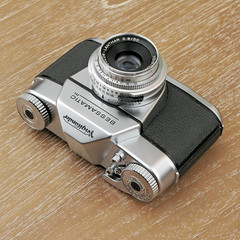
|
| Bessamatic m by Matt Phillips (Image rights) |
In 1964, a meter-less Bessamatic m was introduced, and finally the Bessamatic CS was produced from 1967 to 1969 with a TTL CdS meter. It is an improved Bessamatic Deluxe with the battery compartment behind a door at the front of the finder prism (occupying the space of the selenium photocell in other models) and an added accessory shoe at the top. The frame counter in the CS model counts upwards - that is, it counts the number of frames taken, not remaining - and is reset on opening the film door.
|
|
|
Bessamatic lenses
|
| ||||
|
The range of DKL-mount Bessamatic lenses was as follows:
- 35mm f3.4 Skoparex
- 40mm f2.0 Skopagon
- 50mm f2.0 Septon
- 50mm f2.8 Color Skopar-X
- 50mm f2.8 Color Lanthar
- 90mm f3.4 Dynarex
- 100mm f4.8 Dynarex
- 135mm f4.0 Super Dynarex
- 200mm f4.0 Super Dynarex
- 350mm f5.6 Super Dynarex
- 36–82mm f2.8 Zoomar
Links
In English:
- Bessamatic on Photoethnography by Karen Nakamura
- Use Retina Reflex Lenses on your Voigtlander Bessamatic (and vice versa)
- Bessamatic on apenasimagens.com by Wagner Lungov
- Voigtlander Bessamatic PDF manual (English & Italian at Butkus' OrphanCameras.com
In French:
- Bessamatic at www.collection-appareils.fr by Sylvain Halgand
- Bessamatic m at www.collection-appareils.fr by Sylvain Halgand
In German:
